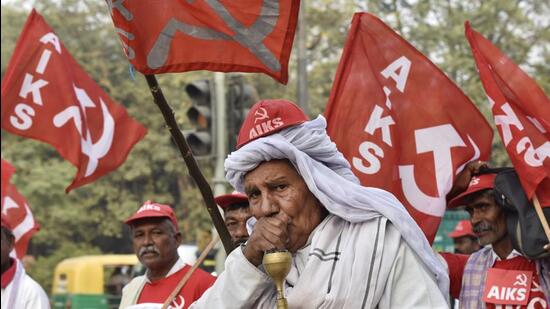When Purvanchal was dotted by Left flags
Communist parties in Uttar Pradesh have faded, failing to win seats in decades. Once dominant in regions like Varanasi, Mau, and Ghazipur, they now struggle against identity politics.
Communist parties have miniscule presence on the political landscape of Uttar Pradesh having failed to win any Lok Sabha seat here in over three decades and not bagging any Vidhan Sabha seat in the state in the last two decades. The last time any communist candidate won in the Lok Sabha elections here was in 1991.

The political disempowerment of the Left parties has been so severe that this time the CPI(M) has not even fielded any candidate in UP while the CPI has decided to contest six seats.
But there was a time when the Left had a dominating presence in eastern UP, central UP and Bundelkhand with communists calling the shots from Modi’s Varanasi to Ansari’s (Mukhtar-Afzal) Mau, Ghazipur.
Not many are aware that the Varanasi Lok Sabha seat once elected a CPI(M) candidate. There were also Communist party MLAs from other constituencies in the region. The most noticeable among them was Udal who represented Kolasla constituency on a CPI ticket for a record nine terms.
Another notable communist name was Satyanarayan Singh, who won from Varanasi Lok Sabha seat in 1967 on CPI(M) ticket while Rajkishore Singh from the party was MLA from Varanasi’s Gangapur assembly constituency twice in 1980s. Dinanath Singh Yadav also represented this constituency on CPI(M) ticket in 1989 and 1992.
The story is not complete without the mention of Sarju Pandey, a communist stalwart and a farmers’ leader from the Communist Party of India, who won state assembly elections five times from Mau, Ghazipur. On two occasions in 1967 and 1971, he won from Ghazipur LS seat on CPI ticket. The neighbouring Ghosi Lok Sabha seat was also dominated by Left parties at that time. Jharkhande Rai of CPI won the Ghosi seat in 1967, 1971 and 1980. After him, the seat was won by CPI’s Vishwanath Shastri in1991.
Such was the popularity of Communist parties in Mau, Ghazipur and Varanasi that people of the region still recall days of Communist representation.
But the Communist party started losing ground to the BJP, Samajwadi party and BSP after the arrival of ‘identity politics’ in the name of ‘Mandal and Kamandal’.
Political analysts said the performance of Left parties in eastern UP had been a mix of “triumphs and challenges”. They initially made significant inroads, but after 1980s, factors such as political polarisation and changing voter dynamics posed formidable challenges for them.
“Historically, regions such as Ghazipur and Mau were considered bastions of communist ideology, boasting prominent leaders like Udal, Sarju Pandey, Jharkhande Rai, Jai Bahadur Singh and Vishwanath Shastri. However, these areas transformed into hotbeds of criminal politics, dominated by the Ansari clan and associates, besides the rise of BJP, BSP and SP as dominant forces,” said Naveen Srivasatava, a resident of Ghazipur.
This shift posed significant challenges to the Left’s influence because of a combination of identity politics and the protection of criminal elements by political parties to expand their horizons.
Leaders within the Communist party lamented the emergence of identity-based politics, which overshadowed their ideological narrative and hindered their ability to mobilise support. Arvindraj Swaroop, secretary of CPI, said: “Along with the identity politics, criminalisation of politics has further eroded the base of communist parties.”
He said, “Despite these obstacles, the Left continues to strive for relevance in UP. We are grappling with the complexities of a rapidly evolving socio-political environment.”
“Communism became the victim of identity politics due to Mandal and Kamandal after 1992. Communist parties never believed in caste or religion politics...,” said Prem Nath Rai, member of party secretariat of CPI(M).






